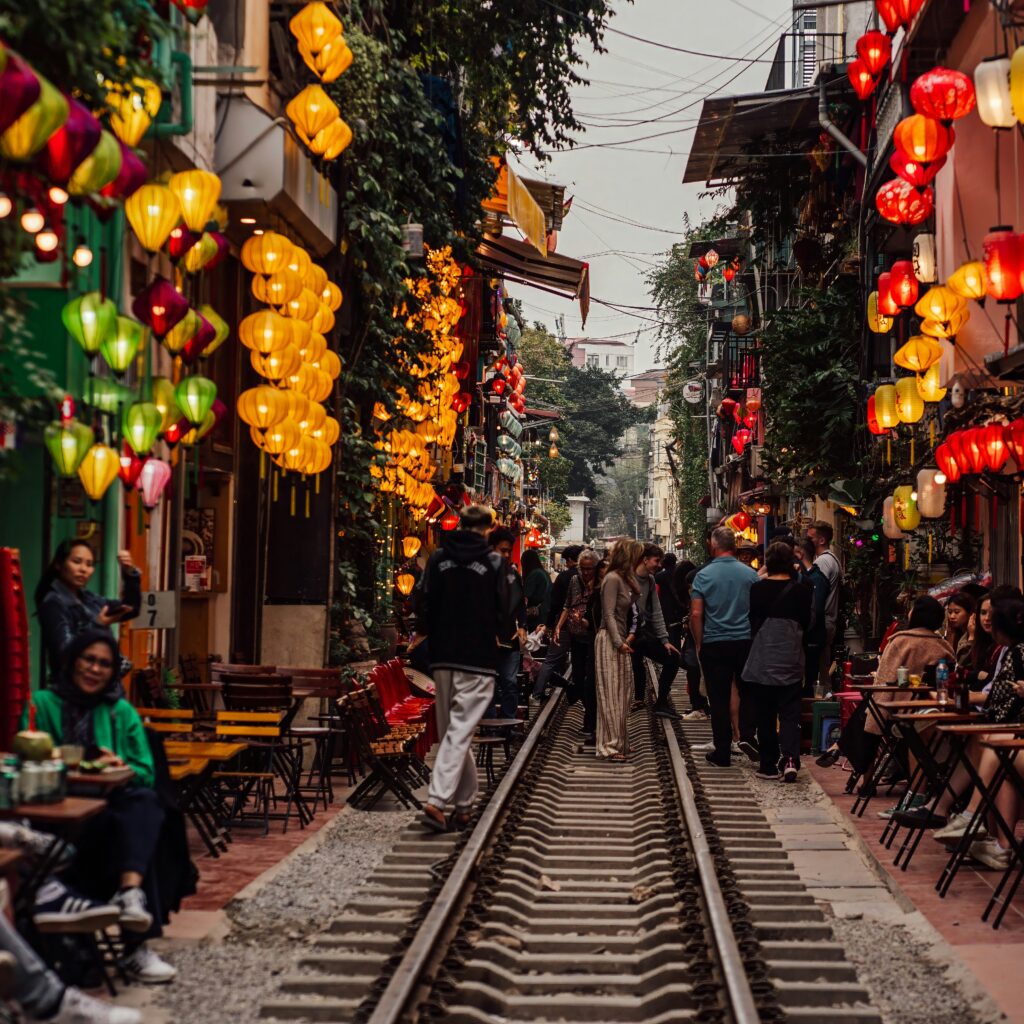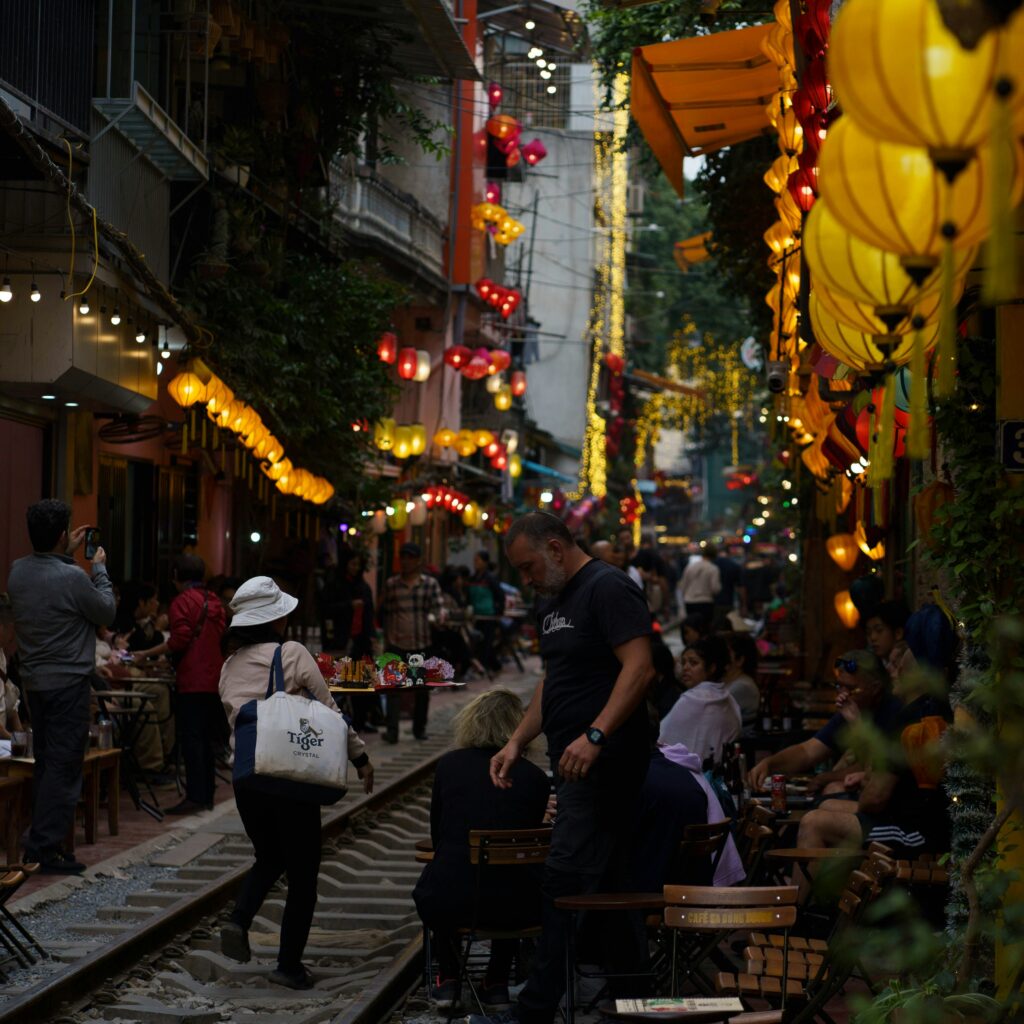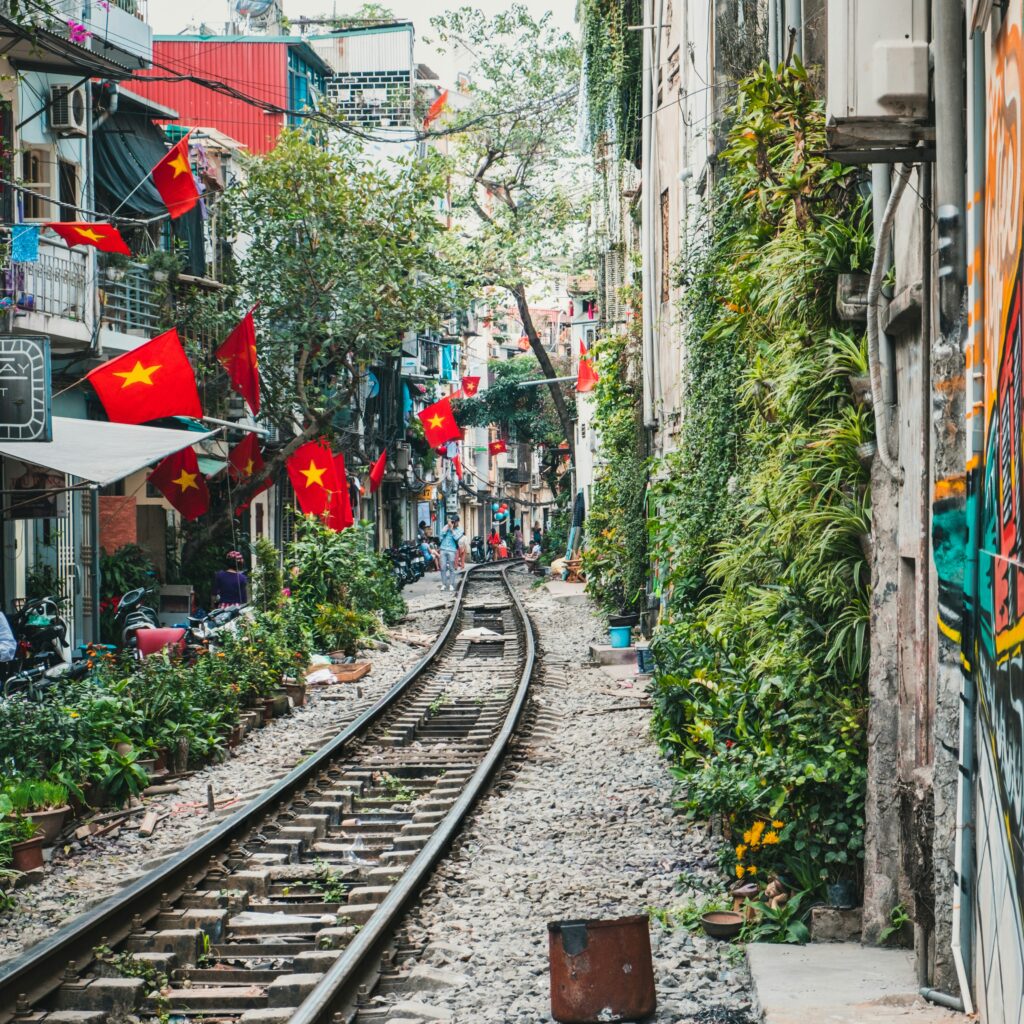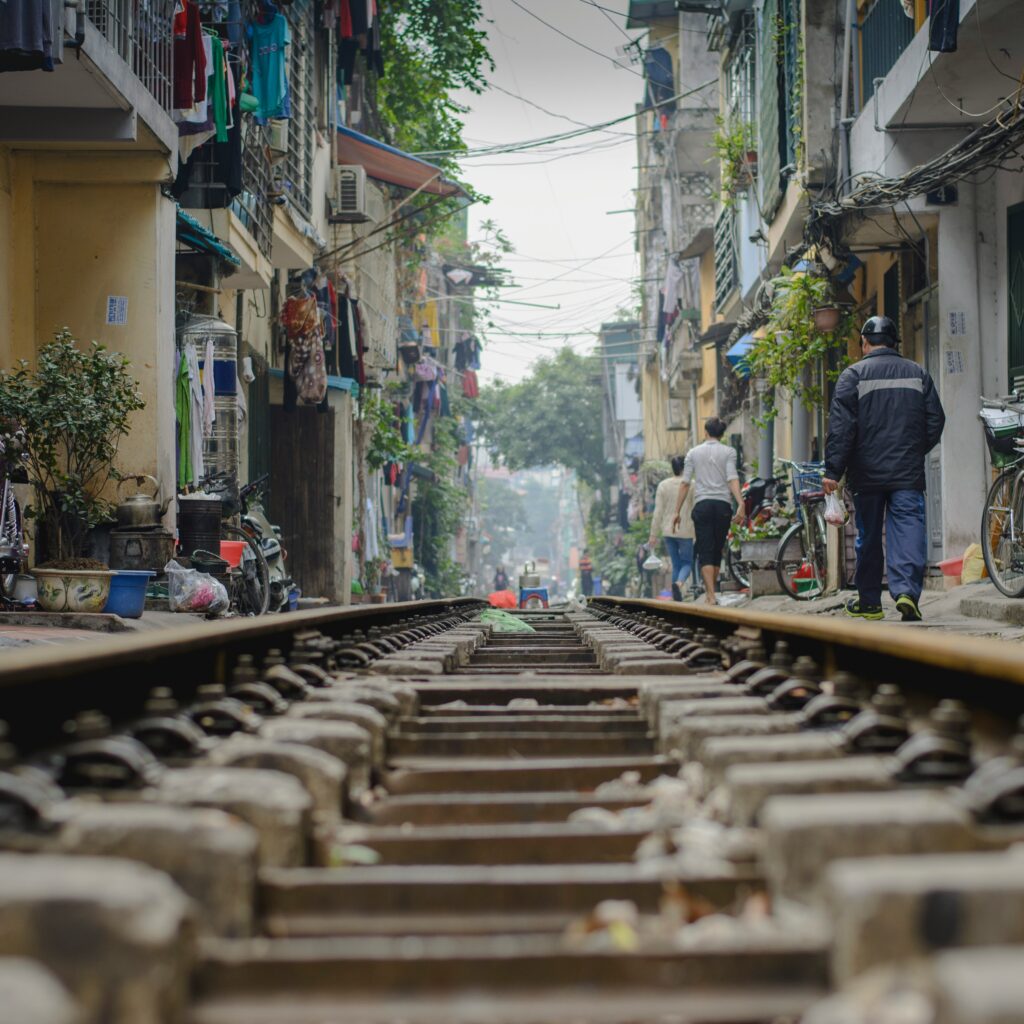Hanoi Train Street: A Hidden Gem in the Heart of the City
Hanoi Train Street is a unique and fascinating destination, offering a glimpse into the city’s rich cultural and historical heritage. From its French colonial-style houses and train station to its cultural landmarks and street food, there’s something for everyone to enjoy. Whether you’re a history buff, culture enthusiast, or simply looking for a unique experience, Hanoi Train Street is a must-visit destination.
- Introduction to Hanoi Train Street
- Specific Location of Hanoi Train Street
- Historical Development of Hanoi Train Street
- Guide to Exploring the Best of Hanoi Train Street
- Best Time to Visit Hanoi Train Street
- How to Get to Hanoi Train Street
- Train Schedule at Hanoi Train Street
- Top Activities at Hanoi Train Street
- Conclusion

Introduction to Hanoi Train Street
Overview of Location and Significance
Nestled between the bustling streets of Hanoi, the Hanoi Train Street is a unique phenomenon where active railway tracks run just meters away from the doorsteps of tightly-packed residential homes. This narrow alley has gained popularity as a must-visit locale due to the juxtaposition of daily life and the occasional passing train.
The area has transformed into a tourist hot spot, attracting visitors from all over the world coming to witness the unusual coexistence of a fully operational railway with daily residential activities. The sight of residents pulling back their belongings and children mere moments before a train rushes past creates a compelling scene that captivates the urban explorer and casual tourists alike.
Brief History and Cultural Importance
The existence of Train Street can be traced back to the French colonial era when Vietnam’s railway system was developed to facilitate the transportation of goods and people across the country. Over the decades, as Hanoi expanded, residents began building their homes closer to the tracks, leading to the unique setup seen today.
Culturally, Train Street reflects the resilience and adaptability of the Vietnamese people. For the residents, the trains have become a part of life, with daily routines timed around the train schedule. Socially, it has promoted community bonding, as residents and visitors interact in close quarters, sharing experiences and stories. Economically, many residents have started small businesses, such as cafes and souvenir shops, catering to the influx of tourists, thereby integrating the tracks into the socio-economic fabric of the area.
Specific Location of Hanoi Train Street

Detailed Address and District in Hanoi
Hanoi Train Street is located in the heart of Hanoi, running between Lê Duẩn and Khâm Thiên streets in the Old Quarter. This area belongs to two main districts: Hoàn Kiếm and Đống Đa. To navigate there, visitors can use public transport such as buses or taxis that are abundant in the area. For a more localized experience, one could rent a bicycle or a scooter. The nearest landmarks to guide visitors are the Hanoi Railway Station and St. Joseph’s Cathedral, from which the Train Street is a short walk away.
Proximity to Key Tourist Attractions
- Hoàn Kiếm Lake: Just a 15-minute drive from Train Street, this iconic lake is a central feature of Hanoi, a place of serenity amidst the busyness of the city, perfect for leisurely walks.
- Hanoi Old Quarter: The neighborhood encapsulates the heart and soul of Hanoi with its bustling streets and markets. This historic area provides insight into traditional Vietnamese culture and is just about 10 minutes away from Train Street.
- St. Joseph’s Cathedral: A beautiful example of neo-Gothic architecture in Vietnam, this cathedral is less than 10 minutes by foot from Train Street.
- Hoa Lo Prison Museum: This museum offers a poignant look at Vietnam’s history, particularly during the French and American wars. It’s located roughly 10 minutes away by vehicle.
- Thăng Long Imperial Citadel: A UNESCO World Heritage Site, this citadel is a testament to Hanoi’s history and is located about 20 minutes from Train Street.
This strategic location amidst key tourist spots makes Train Street a convenient addition to any travel itinerary, providing a vivid slice of local life juxtaposed with the historical and cultural landmarks of Vietnam’s capital.
Historical Development of Hanoi Train Street
Origins and Evolution Over Time
The origins of Hanoi Train Street trace back to the French colonial era when the railway system was first established in Vietnam, primarily to facilitate the transportation of goods for colonial exploitation. The railway lines in Hanoi were constructed during the late 19th century, and over time, as the city’s population began to grow, residents started building their homes closer to these tracks. Despite the close proximity to the danger posed by passing trains, the scarcity of urban space led to more people settling along these narrow strips. Over the decades, what was once a mere railway track gradually transformed into what is now known as the “Train Street,” characterized by its narrow paths flanked by residential buildings and commercial establishments.
Impact on Local Community and Economy
Over the years, Train Street has had a profound impact on both the local community and the economy. Culturally and socially, it has fostered a unique community spirit among the residents. Living in such close quarters and under such unique circumstances, the residents have developed tightly knit relationships and communal practices centered around the train schedule. Economically, the recent surge in tourism driven by the unique charm of Train Street has transformed the local economy. Residents have adapted by turning parts of their homes into cafes, souvenir shops, and eateries, catering to tourists looking to experience this unusual attraction. These small businesses have become vital sources of income for many families, embedding the railway’s presence into the everyday economic fabric of the community. Observing the daily dance between cautions to safety as the Train approaches and the return to normalcy seconds after it passes illustrates the resilience and adaptability of the Train Street community.
This historical and ongoing evolution of Train Street not only highlights the adaptability and resilience of its residents but also underlines the complex relationship between urban development, cultural uniqueness, and economic survival in rapidly modernizing societies.

Guide to Exploring the Best of Hanoi Train Street
Recommended Activities and Experiences for Visitors
- Watching the Train Zoom Past: One of the most thrilling experiences is watching the train pass through the narrow street with just inches to spare from the buildings. It’s a spectacle that brings the daily reality of this unique location to life. Visitors are advised to check the train schedule in advance to not miss this event.
- Enjoying Street Food: The area around Train Street offers a variety of street food that reflects the rich culinary culture of Vietnam. From traditional Vietnamese coffee to Bánh Mì and Phở, visitors can enjoy delicious treats while soaking in the ambiance.
- Local Shops and Cafes: Many residents have transformed their living spaces into quaint cafes and shops. Spending time in these establishments supports the local economy and offers a chance to interact with locals.
- Photography: With its unique setting, Train Street offers countless photographic opportunities. Capturing the everyday life around the tracks, as well as the dramatic moment when the train passes, can make for some compelling shots.
Safety Tips and Rules for Visiting
- Stay Alert: Always be aware of the train schedule and listen for the warning horns. The trains pass through the street at high speeds, and safety should always be the first priority.
- Follow Local Guidance: Residents and local business owners are usually well-informed about the train timings. Heeding their advice helps ensure your safety.
- Keep Off the Tracks: Do not walk on the tracks and ensure you are standing at a safe distance when the train is passing. The alley is narrow, and space is limited.
Cultural Insights and Local Etiquette
- Respect Privacy: While many locals are accustomed to tourists, it’s important to respect their privacy. Avoid taking photos of residents or their homes without permission.
- Support Local Businesses: Purchasing from local vendors or dining at local cafes not only enriches your experience but also contributes to the community.
- Be Mindful of Your Environment: Keeping the area clean and disposing of trash responsibly shows respect for the community and helps maintain the charm of Hanoi Train Street.
- Cultural Appreciation: Take time to appreciate the cultural nuances that make this place special. Engaging respectfully with the community allows for a deeper understanding and a more enriching visit.
This guide will help you make the most out of your visit to Hanoi Train Street, ensuring it is both enjoyable and respectful towards the incredible community that calls this unique location home.
Best Time to Visit Hanoi Train Street
Ideal Seasons and Weather Conditions
- The best time to visit Hanoi Train Street is during the cooler, drier months from October to April. During these months, Hanoi experiences less humidity and rainfall, making outdoor activities more comfortable. The cooler weather is ideal for walking around and exploring the tight, bustling spaces of Train Street without the discomfort of the intense heat and humidity that mark the summer months.
- Specifically, the months of October and November are highly recommended as they offer clear skies and mild temperatures, perfect for photographing Hanoi Train Street in its full urban charm.

Avoiding Peak Tourist Times
- To avoid the crowds and have a more authentic experience at Hanoi Train Street, it is advisable to visit early in the morning or later in the afternoon. These times are not only great for avoiding the bulk of daily tourists but also provide the best light conditions for photography.
- Weekdays are generally less crowded compared to weekends, and visiting during these days can offer a more peaceful and insightful experience. The street is less hectic, and you’ll have a better chance to interact with locals and observe their daily routines without the rush of tourists.
- Additionally, avoiding Vietnamese public holidays and festival periods is wise, as these times can attract larger crowds, not just from international tourists, but also from local visitors coming to see this famous site. By visiting during off-peak times, you can enjoy Train Street at a slower pace, which is conducive to appreciating the unique dynamics and nuances of this extraordinary setting.
By considering these optimal times for your visit, you can maximize your experience of Hanoi Train Street, ensuring a memorable interaction with this unique blend of urban culture and local lifestyle.
How to Get to Hanoi Train Street
Hanoi Train Street, a unique attraction known for its close proximity to the residential houses and cafes lining the tracks, is located between Lê Duẩn and Khâm Thiên Street in Hanoi’s Old Quarter. Here’s how you can reach this intriguing site:
Transportation Options
- Public Transport
- By Bus: Utilize Hanoi’s extensive bus network. The closest bus stops to Train Street are on Lê Duẩn or Đại Cồ Việt streets. Route numbers 2, 3, and 11 will bring you close to the area. For specific bus routes and schedules, check the Hanoi bus website or use a local transit app.
- By Train: Being a train street, it’s ironically not directly serviced by train stops for tourists. However, the Hanoi Railway Station on Lê Duẩn is within walking distance, providing a thematic and practical arrival point.
- Taxi and Ride-Sharing Services
- Taxi: Look for reputable taxi companies like Mai Linh or Vinasun which are known for their reliability. Taxis can be hailed directly from the street or booked via phone.
- Ride-sharing: Apps like Grab or GoViet offer both car and motorbike options, which can be more economical and provide door-to-door service. These apps also help avoid language barrier issues and fare haggling.
Directions from Key Landmarks
- From Hoàn Kiếm Lake
- Walking: It’s about a 25 to 30-minute walk. Head north on Dinh Tien Hoang, turn left onto Lê Duẩn, and continue until you reach Train Street located between alleyways.
- Public Transit: Take bus number 8 towards Đông Mỹ. Alight at Lê Duẩn, which is a short walk away from Train Street.
- From the Temple of Literature
- Walking: It takes about 20 minutes on foot. Head east on Văn Miếu, turn right onto Tôn Đức Thắng, then left onto Lê Duẩn, and proceed to find Train Street.
- Taxi/Ride-Sharing: A quick and direct option, taking approximately 10 minutes depending on traffic.
- From Hanoi Opera House:
- Walking: Approximately a 40-minute walk. Head south on Trang Tien, continue straight onto Phan Chu Trinh, then right on Lê Duẩn until you reach your destination.
- By Bus: Catch bus number 2 from Hanoi Opera House toward Giáp Bát and get off at Lê Duẩn stop.
With these transportation options and directions, visitors can conveniently plan their visit to Hanoi Train Street and immerse themselves in its unique cultural experience. Remember to check the local traffic and train schedules as they can influence your travel time.
Train Schedule at Hanoi Train Street
Exploring Hanoi Train Street offers a unique glimpse into the daily life of locals, as well as the thrilling sight of trains passing just mere feet away from homes and cafes. Here’s what you need to know about the train schedules and the best times to visit:

Overview of Train Timings and Frequency
- Train Timings
Trains typically pass through Hanoi Train Street twice a day. The precise timings can fluctuate, generally around 3:30 PM and 7:30 PM. It’s crucial to check the latest schedule as it can change due to operational demands or maintenance activities.
- Frequency
The frequency is usually consistent with two mainline trains passing each day. However, the schedule is subject to the demands and adjustments of the Vietnam Railways.
Best Times to Witness Trains Passing
Witnessing a train chug along these narrow residential paths is a must-see experience. To get the most out of your visit, consider the following:
- Early Afternoon Viewing
Aim for the earlier schedule around 3:30 PM. This time tends to be less crowded, providing a clearer view and better photo opportunities. The natural daylight during this time also enhances the visual experience.
- Consider Weekdays
Weekdays are generally less crowded compared to weekends. Visiting on a weekday can give you a more relaxed experience without the large tourist crowds.
- Arrive Early
Arriving 15-20 minutes before the scheduled train allows you to secure a good viewing spot and take in the unique atmosphere of the area.
- Safety and Courtesy
Always remain vigilant and respectful of the local residents. Keep a safe distance from the tracks as the train approaches and heed any instructions or signs posted in the area.
By planning according to the schedule and choosing the optimal time for your visit, you can witness this fascinating aspect of Hanoi’s culture effectively and safely. Enjoy your visit to Hanoi Train Street with these tips in mind!
Top Activities at Hanoi Train Street
Hanoi Train Street offers a blend of thrilling experiences and cultural immersion. Whether you’re there to witness the iconic train passage, enjoy local flavors, or capture unique moments, here’s how to make the most of your visit:
Watching the Train Pass Closely
Unique Experience: Observing a train pass through this narrow street lined with homes and cafes is a breathtaking experience. The proximity at which these trains travel next to everyday life is something truly unique to this area.
Sampling Local Street Food and Beverages
Must-Try Food and Beverages
- Egg Coffee: A signature Vietnamese beverage, available at cafes along the street.
- Bánh mì: Enjoy this Vietnamese sandwich from a local vendor for a quick and flavorful meal.
- Phở: Savour this classic Vietnamese noodle soup, offered at various food stalls around the area.
- Local Snacks: Look for fried spring rolls or fresh fruit served by street vendors for a genuine taste of Vietnam’s street food culture.
Capturing Memorable Photos of Trains and Surroundings
Best Photo Spots and Angles
- Before the Train Arrives: Position yourself towards the ends of the street for a head-on shot as the train approaches.
- From Nearby Cafes: Some cafes offer views from above. Order a drink and wait for the perfect moment as the train glides beneath you.
- Street Level Angles: Capture the contrast between the daily life of residents and the imposing size of the train by taking shots at street level.
Interacting with Local Residents
Learning About Local Culture
- Engage with the locals who might share stories about living in such a unique place. Respect their privacy and approach conversations with courtesy.
- Observe and perhaps participate in daily activities to appreciate the lifestyle here. This can be an enriching experience that adds depth to your visit.
Visiting Hanoi Train Street is more than just watching trains; it’s about experiencing a vibrant community in a singular setting. Enjoy these activities responsibly, keeping in mind the safety and well-being of both yourself and the residents.
Conclusion
Hanoi Train Street is a thrilling showcase of Vietnam’s urban culture, offering a unique blend of daily life with the dramatic passage of trains just inches away from local homes and cafes. This area is not only a photographer’s delight but also a culinary hotspot for those eager to taste authentic Vietnamese street food. As a symbol of Hanoi’s vibrant and resilient spirit, it provides deep cultural insights and encourages responsible tourism. Thus, it stands out as a must-visit for any traveler seeking to experience the real essence of Hanoi and engage directly with its people and traditions.
